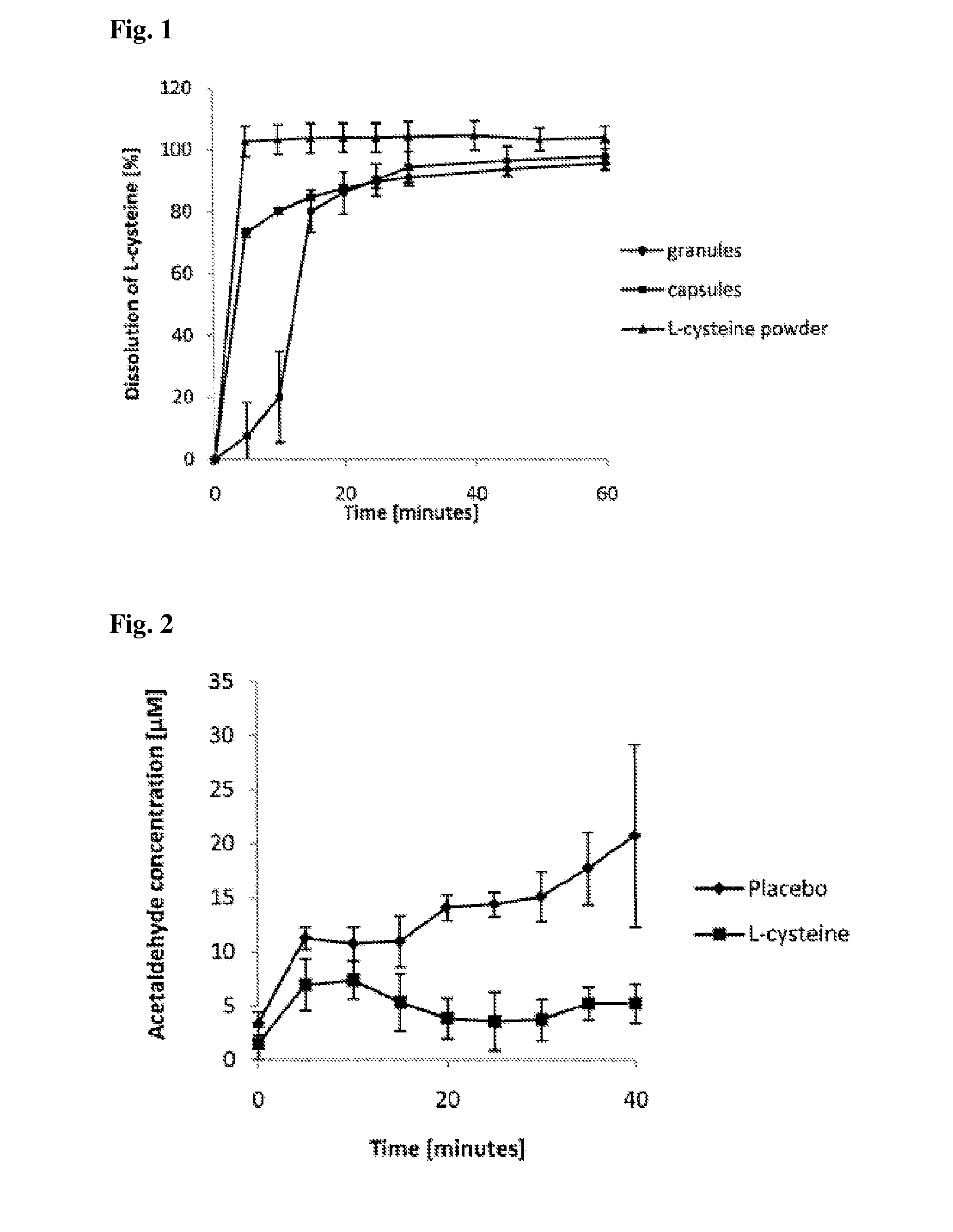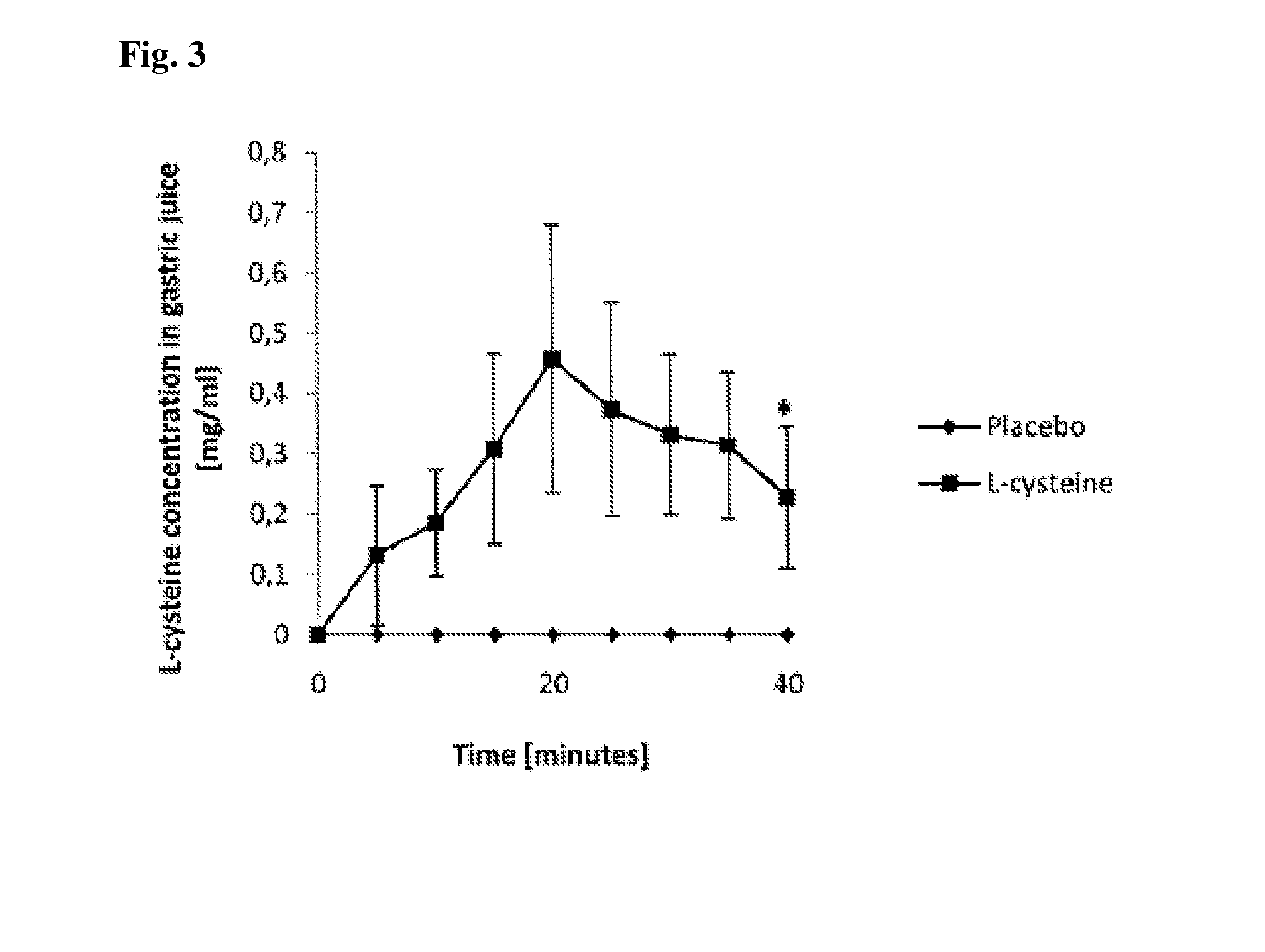Encapsulated composition for binding aldehydes in the stomach
a technology of aldehyde and composition, which is applied in the direction of biocide, drug composition, peptide/protein ingredients, etc., can solve the problems of high risk factor for stomach cancer and high achieve the effect of reducing the risk of stomach cancer, intestine and/or colon cancer, and reducing the risk of stomach acid formation
- Summary
- Abstract
- Description
- Claims
- Application Information
AI Technical Summary
Benefits of technology
Problems solved by technology
Method used
Image
Examples
example 1
Preparation of Capsules According to the Present Invention
[0098]The capsules were prepared by mixing 500 g of L-cysteine (Gonmisol S.A., Spain), 500 g of Eudragit RS-PO, forming a matrix structure (Evonik Röhm GmbH, Germany), and 1 kg of calcium hydrogen phosphate (Emcompress® Anhydrous; Mendell a Penwest Company, Lakeville, Minn.) in a Turbula Powder Blender (Glen Mills Inc., Clifton, N.J.) for 10 minutes.
[0099]The mixture was wet-granulated using ethanol. The obtained wet granules were sieved using a 2-mm sieve, and thereafter allowed to dry at room temperature in a fume hood for 24 hours. The dried granules were sieved using a 1.68 mm and 1.18 mm sieves, and the obtained middle fraction was collected for capsulation.
[0100]Simultaneously, a placebo formulation, where the L-cysteine was replaced by the same amount of CaHPO4, was prepared following the exact same procedure.
[0101]The obtained matrix granules were weighed into HPMC capsules so that the desired amount of cysteine per c...
example 2
Dissolution Test for the Capsules
[0104]Dissolution tests were carried out on the capsules of Example 1 according to the USP I method (USP 24) (The United States Pharmacopeia 2001). A standard curve was prepared between 0.01 and 0.6 mg / ml (y=2.196+0.0016, r2=0.9999). The medium used was 500 ml of pH 1.2 HCl buffer. The rotation rate of the baskets was 100 rpm, and the temperature of the medium was +37° C. (±0.5). Samples were taken at 5-minute intervals for the first half hour and thereafter at 10-minute intervals for the remaining 2 hours. L-cysteine was detected in flow-through cells (10 mm) at a wavelength of 213 nm. The results were calculated by using dissolution software. The system was equipped with a bath and a pump (Sotax AT7 UV Dissolution System, Stax, Allschwil, Switzerland) and a spectrophotometer (PerkinElmer, Lambda 25, PerkinElmer, Inc., Waltham, Mass.), the software used for the test and for calculating the results was WinSotax (Sotax).
[0105]This dissolution test sho...
example 3
Acetaldehyde-Binding
Study Procedure:
[0106]Seven volunteers (2 men, 5 women) with achlorhydric atrophic gastritis participated in the study. Their mean age±SD was 57±7 years and mean body weight 75±22 kg. All volunteers were non-smokers and normal social drinkers, with an average consumption of 50 g or less of ethanol per week.
[0107]A randomized double-blinded placebo-controlled study design was used, and each participant served as his / her own control. The 2 study days were separated by at least a 3-day interval. The volunteers were told to refrain from alcohol intake for 24 hours and food intake for 12 hours prior to the study.
[0108]A nasogastric tube (Duodenal tube Levin, CH10, Unomedical, Denmark) was inserted into the subjects to a depth of 55 cm at the beginning of each study day. The tube was lubricated with Xylocain gel (AstraZeneca, Sodertalje, Sweden) containing no ethanol. During the tube placement, the volunteers were given 100 ml of water to facilitate swallowing of the t...
PUM
| Property | Measurement | Unit |
|---|---|---|
| time | aaaaa | aaaaa |
| time | aaaaa | aaaaa |
| diameter | aaaaa | aaaaa |
Abstract
Description
Claims
Application Information
 Login to View More
Login to View More - R&D
- Intellectual Property
- Life Sciences
- Materials
- Tech Scout
- Unparalleled Data Quality
- Higher Quality Content
- 60% Fewer Hallucinations
Browse by: Latest US Patents, China's latest patents, Technical Efficacy Thesaurus, Application Domain, Technology Topic, Popular Technical Reports.
© 2025 PatSnap. All rights reserved.Legal|Privacy policy|Modern Slavery Act Transparency Statement|Sitemap|About US| Contact US: help@patsnap.com


